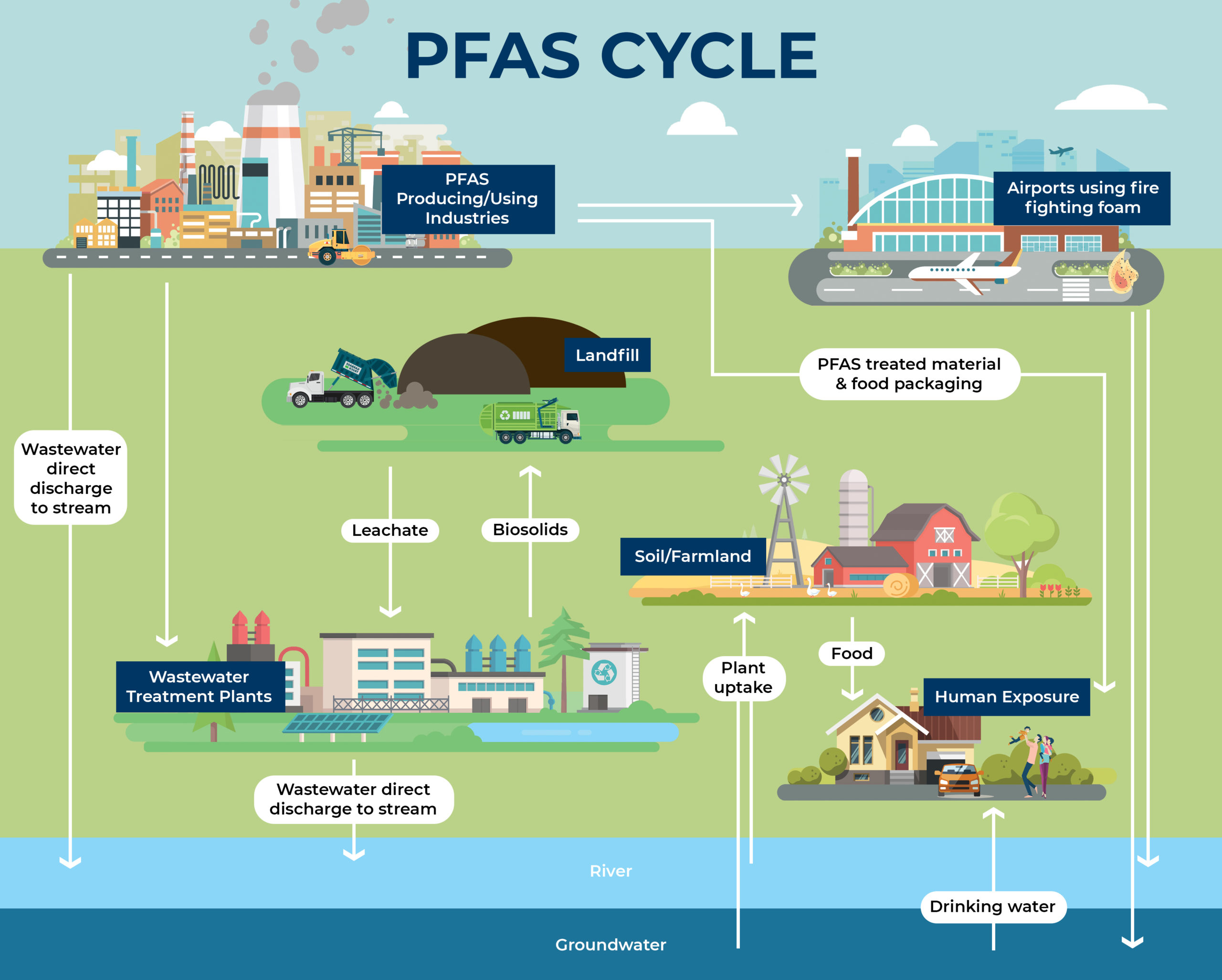PFAS: The “Forever Chemical” Penetrating the World Around Us
We wish some things could last forever.
That shouldn’t include chemicals.
“Forever chemicals” have recently been under increased scrutiny, proving to be problematic chemicals that are penetrating the world around us.
More studies are being conducted showing that PFAS could be spreading and making its way into groundwater, soil, our food and even drinking water.
What are PFAS?
Per- and polyfluoroalkyl substances (PFAS) are a large group of man-made chemicals widely used in consumer and industry products due to their water, heat and oil-repellent properties.
The carbon-fluorine bond in PFAS is the strongest naturally occurring bond because of the short distance between the atoms. This means the bond breaks down very slowly in the environment. The long-lasting properties of PFAS are why they’ve been dubbed as a “forever chemical.”
These durable chemicals are a double-edged sword. The invention of PFAS brings many practical and safety benefits to society, but studies have shown that human exposure to PFAS may also be linked to harmful health effects.
History
PFAS is a blanket term for thousands of complex chemicals that have been used since the 1940s. Restrictions have since been placed on a handful of these harmful chemicals, but there are still many others within the PFAS family that continue to be produced. View this Family Tree of PFAS for a visual of these substances.
These unique synthetic chemicals are contained in thousands of everyday products, such as:
-
-
- food packaging
- clothing
- cleaning products
- paints
- Teflon (nonstick cookware)
- fire-fighting foam
-
Firefighting foams are highly effective for extinguishing fuel fires, but have also been a major source of PFAS contamination, especially at airports and air force bases.
Regulatory agencies and governments around the world have taken greater steps to begin testing for, regulating and mitigating releases of PFAS. Researchers are also working to better understand the effects of PFAS. Part of this begins with how to efficiently measure PFAS levels in our air, water, soil and food sources.
Places where PFAS are most problematic and found in concentrated amounts include:
-
-
- Department of Defense (DoD) bases
- Fire training facilities
- Landfills
- Airports
- Water/wastewater plants and providers
-
When releases of PFAS occur at these places, the potential exists for migration into groundwater, drinking water and surface water sources. Increased mitigation and sampling efforts to understand the extent of the releases are necessary to reduce human exposure and the migration of PFAS.

The EPA published a health advisory in 2016 that established safe levels of certain PFAS (PFOS and PFOA) in drinking water at no more than 70 parts per trillion (PPT). A formal PFAS Action Plan was established in 2019 (updated February 2020) to outline short and long-term goals.
The Safe Drinking Water Act requires that once every five years the EPA issue a list of unregulated contaminants to be monitored by public water systems (PWS). This list was last published on Dec. 27, 2021.
The EPA started a new round of PWS monitoring which included 29 additional PFAS compounds in the Unregulated Contaminant Monitoring Rule (UCMR) 5, which is scheduled to be completed by 2025. In March 2023, the EPA proposed a 4 PPT maximum concentration level (MCL) for PFOA and PFOS in water, along with four other compounds (PFNA, PFHxS, PFBS and GenX). These MCLs are anticipated to start being enforced in the coming years.
How PFAS is Impacting Our Environment
Did you know that traces of PFAS can be found in nearly everyone?
Most people in the U.S. have low amounts of PFAS in their blood, due to exposure by breathing, drinking, eating or touching those chemicals.
Studies are showing that some PFAS compounds can bioaccumulate in humans, animals and living organisms, and may have adverse health and environmental effects.
Health effects
Exposure to PFAS is being linked to various negative health issues and increased risk of cancer. Human exposure is a critical aspect that researchers are studying more deeply. Because there are thousands of PFAS chemicals, it is challenging to study and assess the full spectrum of risks.
Bioaccumulation
PFAS can spread not only in water and soil, but also to the plants and food we eat. This accumulation throughout the food chain further exposes humans who consume contaminated food.
Environmental Impact
Contamination of the environment poses various risks to ecosystems and wildlife. PFAS constituents can leach into soil, groundwater and surface water, exposing livestock and wild animals.
Drinking Water Contamination
A new study by USGS has shown that at least 45 percent of the nation’s tap water contains PFAS. Most of the contamination is located near larger urban areas and military bases.
View an interactive map developed by Environmental Working Group (EWG) to see where PFAS contaminants have been found in drinking water.
Consumer Products
Most of our non-stick cookware, stain-resistant clothing and carpets, and even facial makeup contains “forever chemicals.”
Microwavable popcorn bags and paper plates are just a couple of everyday items that expose us to low amounts of PFAS.
Check your makeup and household product ingredients with EWG’s skin deep searcher.
Research and innovation of PFAS treatment technologies will be of utmost importance to minimize exposure to these “forever chemicals.” This ongoing work aims to balance the benefits of PFAS while better protecting our health and the environment.
How Halff is Leading the Way
Soil sampling can provide important data on how surrounding areas are being affected by PFAS contamination. Image source: Stewart Cohen photography
Halff leads the way in staying up to date on the latest federal and state regulatory guidance for PFAS sampling, analysis, data management and disposal options.
Our environmental team understands the various sources and potential migration pathways associated with PFAS contamination. We can review site data and develop cost effective sampling plans that provide sufficient data to properly evaluate regulatory requirements.
We work to provide accurate, quality data for our clients by developing sampling protocols to prevent cross-contamination and minimize PFAS containing materials brought on-site during sampling efforts.
Our sampling techniques have been developed and approved by industry standard leaders, and we work tirelessly to support our clients’ needs by conducting continual QA/QC on our protocols and our data.
Our Environmental Remediation and Compliance (ERC) team is currently leading efforts to investigate more than 30 sites at four DoD Air Force bases across Oklahoma and Texas.
The ERC team will mobilize to the field in fall of 2023 to install hundreds of soil borings/monitor wells and collect thousands of soil, sediment, surface water and groundwater samples for analysis of PFAS. We will use the analytical data to characterize the site, delineate the nature and extent of PFAS contamination resulting from past aqueous film-forming foam (AFFF) releases, identify potential exposure pathways, quantify human health and ecological risks, and evaluate remedial alternatives.
Our experienced professionals have developed a network of teaming partners to supplement our investigation capabilities and provide remedial solutions. These solutions can include Granular Activated Carbon (GAC) or Anion Exchange Resin (AER), and also have solutions for the on-site treatment of water.
Our Team actively monitors and evaluates potential remedial solutions that are being tested and refined, including the treatment of soil on-site. We also understand the challenges of dealing with comingled groundwater plumes and surface water affected with metals and/or chlorinated solvents, which would require filtration/treatment prior to introduction into a PFAS remedial system.
Our PFAS experience is unique and we’re leading the industry by:
-
-
- Training our environmental professionals on evaluating migration and exposure pathways.
- Reviewing and understanding the latest federal and state guidance for sampling, analysis, data management and disposal.
- Procuring DoD ELAP accredited laboratories.
- Practicing PFAS-specific sampling protocols to minimize cross contamination in both soil and water (i.e. careful choice of sampling instruments, clothing, PPE, sunscreen, etc.).
- Performing data validation to meet Project Data Quality Objectives under Classification, Labelling and Packaging (CLP) or DoD guidelines.
- Working with states and the DoD to determine proper disposal of investigation-derived waste.
-
Need expert PFAS testing and analysis? Halff is leading many PFAS projects with accredited laboratories and high testing standards, to provide quality data and data validation. We set the standards at a high level.
Let Halff help you take the first step in PFAS testing by contacting Senior Project Manager Oscar Martinez (Oscar.Martinez@halff.com).









